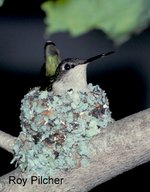One of the waited for migrants from the tropics each spring is the Ruby-throated Hummingbird. These living jewels brighten our gardens and delight the eye as they zoom around the yard. Plantings suitable for providing a food source are one way to attract hummers to your yard. Some of the favored varieties include Bee Balm, Trumpet Vine, Lantana, and Cardinal Flower.
 Ruby-throated Hummingbird (female)In addition to providing natural plantings, feeders are a popular way to get a close look at these mighty mites. The formula for making your own nectar could not be simpler. A ratio of 4 parts water to1 part white sugar is recommended. Just boil the water, add the sugar, stir until dissolved and cool. DO NOT use honey, as it will cause a fungal infection. Be sure to store any extra food in the refrigerator.
Ruby-throated Hummingbird (female)In addition to providing natural plantings, feeders are a popular way to get a close look at these mighty mites. The formula for making your own nectar could not be simpler. A ratio of 4 parts water to1 part white sugar is recommended. Just boil the water, add the sugar, stir until dissolved and cool. DO NOT use honey, as it will cause a fungal infection. Be sure to store any extra food in the refrigerator.
You may wonder if adding red coloring will help attract the birds more readily. An article in the May/June Birdwatcher’s Digest discusses this topic. It goes into detail as to facts and figures, but what it boils down to is that, given the body ratio of the little birds, hummingbirds receive a dosage that greatly exceeds the FDA standard for humans. The story tells that that after only two feedings of food with coloring the bird excreted the red dye for 24 hours. So to be on the safe side, do not use the coloring. Most feeders have plenty of red on them to make them attractive to the birds. Just be sure to change the solution every 3 days and clean and rinse the feeders with hot water to avoid any mold that may form. Brushes can be purchased at your local bird emporium to help in getting the grunge out.
Looking at eBird I see the hummers are back in Vermont so get ready, you know impatient these tiny, feathered friends are when you don’t have their food out for them!